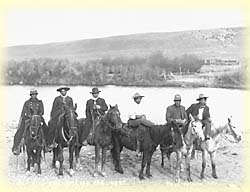By the middle of the nineteenth century, many Native people were working as cowboys and ranchers. They brought to these new professions their horsemanship and their experience in herding large animals. They were also taking up farming, drawing upon their long tradition of growing and harvesting plants, including corn, beans and squash. The transition from hunting to an economy based on ranching and farming began with the expansion of trading partnerships to include the newly arrived European fur traders. There were new markets for pemmican, buffalo robes, salmon and horses, and a growing need for European trade goods. Native people found employment tending the cattle and horses belonging to the trading companies. By the 1830s, several communities had taken up ranching and farming, particularly in the Red River district of Manitoba, Minnesota the Dakotas, and by the 1840s, in the Okanagan valley. Introduction | Early Ranching | Ranching Life | Contemporary Ranching Life | Community Stories | Transition to Rodeo SACRED BEINGS | RANCHING | ENTERTAINMENT | RODEO | ARTS AND INDUSTRIES |



